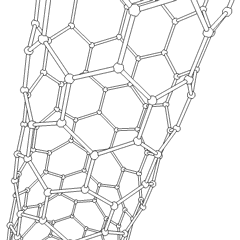Carbon/Carbon
 |
Carbon/carbon is used in manufacturing |
Carbon-carbon composites consist of highly-ordered graphite fibers embedded in a carbon matrix. C/C composites are made by gradually building up a carbon matrix on a fiber preform through a series of impregnation and pyrolysis steps or chemical vapor deposition. C/C composites tend to be stiffer, stronger and lighter than steel or other metals.
Processing carbon-carbon composites consists of building up of the carbon matrix around the graphite fibers. There are two common ways to create the matrix: through chemical vapor deposition and through the application of a resin.
Chemical vapor deposition (CVD) begins with a preform in the desired shape of the part, usually formed from several layers of woven carbon fabric. The preform is heated in a furnace pressurized with an organic gas, such as methane, acetylene or benzene. Under high heat and pressure, the gas decomposes and deposits a layer of carbon onto the carbon fibers. The gas must diffuse through the entire preform to make a uniform matrix, so the process is very slow, often requiring several weeks and several processing steps to make a single part.
In the second method a thermosetting resin such as epoxy or phenolic is applied under pressure to the preform, which is then pyrolized into carbon at high temperature. Alternatively, a preform can be built up from resin-impregnated carbon textiles (woven or non-woven) or yarns, then cured and pyrolized. Shrinkage in the resin during carbonization results in tiny cracks in the matrix and a reduction in density. The part must then be re-injected and pyrolized several times (up to a dozen cycles) to fill in the small cracks and to achieve the desired density. Densification can also be accomplished using CVD.
A limiting factor on the use of carbon-carbon composites is the manufacturing expense associated with these slow and complex conventional methods.

Carbon-carbon nanotube
Newest invention is use of carbon nanotubes. The strength of the sp2 carbon-carbon bonds gives carbon nanotubes amazing mechanical properties. The stiffness of a material is measured in terms of its Young's modulus, the rate of change of stress with applied strain. The Young's modulus of the best nanotubes can be as high as 1000 GPa which is approximately 5x higher than steel. The tensile strength, or breaking strain of nanotubes can be up to 63 GPa, around 50x higher than steel. These properties, coupled with the lightness of carbon nanotubes, gives them great potential in all applications but limiting factor is again manufacturing expense.
To know more about carbon, check out articles about Carbon fiber and Carbon fiber composites.






